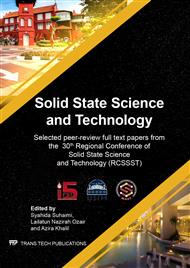[1]
W. Zhang, Z. Liu, S. Zhu, J. Chen, G. Xu, Electrochem. Commun. 2010, 12, 1291-1293.
Google Scholar
[2]
A. A. Gouda, A. S. Amin, Spectrochim. Acta A 2014, 120, 88-96.
Google Scholar
[3]
N. G. Beck, R. P. Franks, K. W. Bruland, Anal. Chim. Acta 2002, 455, 11-22.
Google Scholar
[4]
V. N. Losev, O. V. Buyko, A. K. Trofimchuk, O. N. Zuy, Microchem. J. 2015, 123, 84-89.
Google Scholar
[5]
S. L. Zhao, F. S. Chen, J. Zhang, S. B. Ren, H. D. Liang, S. S. Li, J. Ind. Eng. Chem. 2015, 27, 362-367.
Google Scholar
[6]
A. Afkhami, F. Soltani-Felehgari, T. Madrakian, H. Ghaedi, M. Rezaeivala, Anal. Chim. Acta 2013, 771, 21-30.
Google Scholar
[7]
aB. L. Li, Z. L. Wu, C. H. Xiong, H. Q. Luo, N. B. Li, Talanta 2012, 88, 707-710; bJ. H. Luo, X. X. Jiao, N. B. Li, H. Q. Luo, J. Electroanal. Chem. 2013, 689, 130-134.
Google Scholar
[8]
A. Giacomino, O. Abollino, M. Lazzara, M. Malandrino, E. Mentasti, Talanta 2011, 83, 1428-1435; bA. M. Beltagi, E. M. Ghoneim, M. M. Ghoneim, Int. J. Environ. Anal. Chem. 2011, 91, 17-32.
DOI: 10.1016/j.talanta.2010.11.033
Google Scholar
[9]
K. Gibbon-Walsh, P. Salaün, C. M. G. van den Berg, Anal. Chim. Acta 2010, 662, 1-8; bM. C. Teixeira, E. d. F. L. Tavares, A. A. Saczk, L. L. Okumura, M. d. G. Cardoso, Z. M. Magriotis, M. F. de Oliveira, Food Chem. 2014, 154, 38-43.
Google Scholar
[10]
C. R. T. Tarley, V. S. Santos, B. E. L. Baêta, A. C. Pereira, L. T. Kubota, J. Hazard. Mater. 2009, 169, 256-262.
Google Scholar
[11]
P. R. d. Oliveira, A. C. Lamy-Mendes, J. L. Gogola, A. S. Mangrich, L. H. Marcolino Junior, M. F. Bergamini, Electrochim. Acta 2015, 151, 525-530; bF. E. Salih, A. Ouarzane, M. E. L. Rhazi, Arab J. Chem. (2015).
DOI: 10.1016/j.electacta.2014.11.057
Google Scholar
[12]
Y. Wang, Y. Wu, J. Xie, X. Hu, Sensor Actuat. B-Chem 2013, 177, 1161-1166; bF. Fathirad, D. Afzali, A. Mostafavi, T. Shamspur, S. Fozooni, Electrochim. Acta 2013, 103, 206-210; cM. R. Ganjali, N. Motakef-Kazami, F. Faridbod, S. Khoee, P. Norouzi, J. Hazard. Mater. 2010, 173, 415-419.
DOI: 10.1016/j.electacta.2013.03.162
Google Scholar
[13]
A. Afkhami, H. Ghaedi, T. Madrakian, M. Rezaeivala, Electrochim. Acta 2013, 89, 377-386; bA. Afkhami, H. Bagheri, H. Khoshsafar, M. Saber-Tehrani, M. Tabatabaee, A. Shirzadmehr, Anal. Chim. Acta 2012, 746, 98-106; cM. Ghiaci, B. Rezaei, M. Arshadi, Sensor Actuat. B-Chem 2009, 139, 494-500.
DOI: 10.1016/j.aca.2012.08.024
Google Scholar
[14]
G. Bia, L. Borgnino, P. I. Ortiz, V. Pfaffen, Sensor Actuat. B-Chem 2014, 203, 396-405; bS. L. C. Ferreira, R. E. Bruns, H. S. Ferreira, G. D. Matos, J. M. David, G. C. Brandão, E. G. P. da Silva, L. A. Portugal, P. S. dos Reis, A. S. Souza, W. N. L. dos Santos, Anal. Chim. Acta 2007, 597, 179-186.
DOI: 10.1016/j.aca.2007.07.011
Google Scholar
[15]
N. Mohamad, F. Huyop, H. Y. Aboul-Enein, N. A. Mahat, R. A. Wahab, Biotechnol Biotechnol Equip. 2015, 29, 732-739; bR. A. Wahab, M. Basri, R. N. Z. R. A. Rahman, A. B. Salleh, M. B. A. Rahman, N. Chaibakhsh, T. C. Leow, Biotechnol Biotechnol Equip. 2014, 28, 1065-1072.
DOI: 10.1080/13102818.2015.1034177
Google Scholar
[16]
N. Chaibakhsh, M. B. A. Rahman, M. Basri, Chem. Prod. Process Model. 2012, 7.
Google Scholar
[17]
Y. Zhao, X.-m. Hu, B.-h. Jiang, L. Li, Desalination 2014, 336, 64-71.
Google Scholar
[18]
N. H. C. Marzuki, F. Huyop, H. Y. Aboul-Enein, N. A. Mahat, R. A. Wahab, Biotechnol Biotechnol Equip. 2015, 1-15.
Google Scholar
[19]
W. Liu, P. Yin, X. Liu, R. Qu, Bioresour. Technol. 2014, 173, 266-271.
Google Scholar
[20]
S. Dwivedi, S. Sharma, R. Mishra, Adv. Manuf. 2014, 2, 303-317.
Google Scholar
[21]
S. Abbasi, A. Bahiraei, F. Abbasai, Food Chem. 2011, 129, 1274-1280.
Google Scholar
[22]
S. Guo, X. Wu, J. Zhou, J. Wang, B. Yang, B. Ye, J. Electroanal. Chem. 2011, 655, 45-49.
Google Scholar
[23]
A. Ourari, H. Nora, C. Noureddine, A. Djouhra, Electrochim. Acta 2015, 170, 311-320.
Google Scholar
[24]
A. Afkhami, T. Madrakian, S. J. Sabounchei, M. Rezaei, S. Samiee, M. Pourshahbaz, Sensor Actuat. B-Chem 2012, 161, 542-548.
Google Scholar
[25]
J. Zolgharnein, T. Shariatmanesh, A. Babaei, Sensor Actuat. B-Chem 2013, 186, 536-544.
Google Scholar


